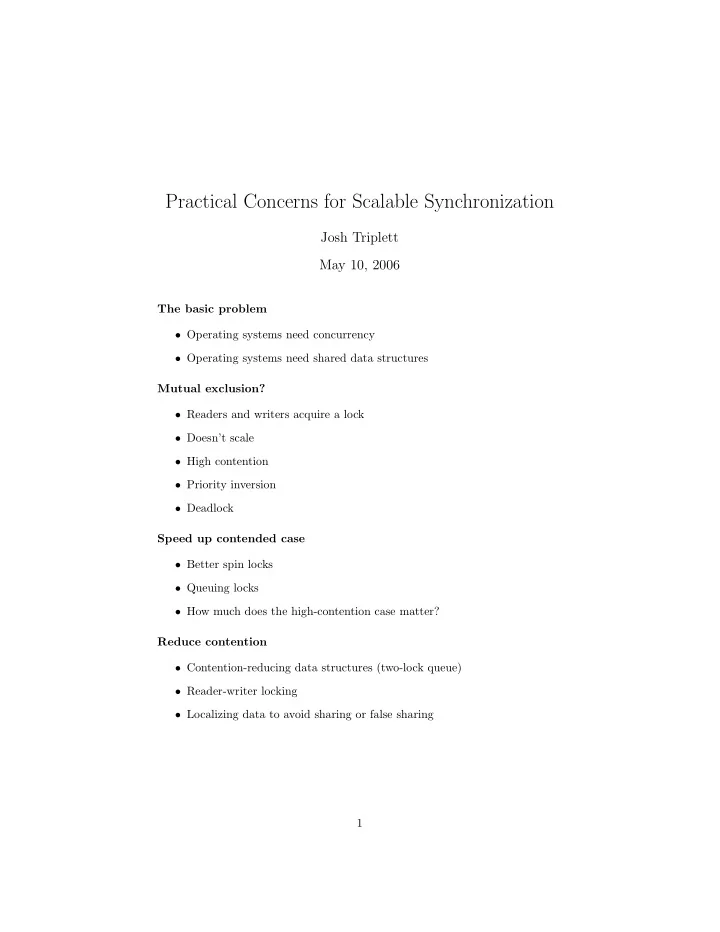

Practical Concerns for Scalable Synchronization Josh Triplett May 10, 2006 The basic problem • Operating systems need concurrency • Operating systems need shared data structures Mutual exclusion? • Readers and writers acquire a lock • Doesn’t scale • High contention • Priority inversion • Deadlock Speed up contended case • Better spin locks • Queuing locks • How much does the high-contention case matter? Reduce contention • Contention-reducing data structures (two-lock queue) • Reader-writer locking • Localizing data to avoid sharing or false sharing 1
Contention less relevant • Atomic instructions expensive • Memory barriers expensive • 3 orders of magnitude worse than regular instruction • For locking, lock maintenance time dominates • For non-blocking synchronization, CAS or LL/SC time dominates Avoiding expensive instructions • Writer needs locking or non-blocking synchronization • What about the reader? • Need to ensure that the reader won’t crash • Crashes caused by following a bad pointer • Assignment to an aligned pointer happens atomically • Insert and remove items atomically • Need some memory barriers: prevent insertion before initialization Reclamation • What about reclamation? • Can remove item atomically: reader sees structure with or without • Can’t free item immediately: • What if memory reused, reader interprets new data as pointer to item? • Segmentation fault: core dumped • (Best case scenario) Deferred reclamation • Insertion fine anytime • Removal fine anytime, but. . . • Can’t reclaim an item out from under a reader • Removal prevents new readers • How to know current readers stopped using it? 2
Deferred reclamation procedure • Remove item from structure, making it inaccessible to new readers • Wait for all old readers to finish • Free the old item • Note: only synchronizes between readers and reclaimers, not writers • Complements other synchronization Epochs • Maintain per-thread and global epochs • Reads and writes associated with an epoch • When all threads have passed an epoch, free items removed in previous epochs • Reader needs atomic instructions, memory barriers Hazard pointers • Readers mark items in use with hazard pointers • Writers check for removed items in all hazard pointers before freeing. • Reader still needs atomic instructions, memory barriers Problem: reader efficiency • Epochs and hazard pointers have expensive read sides • Readers must also write • Readers must use atomic instructions • Readers must use memory barriers • Can we know readers have finished as an external observer? Quiescent-state-based reclamation • Define quiescent states for threads • Threads cannot hold item references in a quiescent state • Let “grace periods” contain a quiescent state for every thread • Wait for one grace period; every thread passes through a quiescent state • No readers could hold old references, new references can’t see removed item 3
Read Copy Update (RCU) • Read-side critical sections • Items don’t disappear inside critical section • Quiescent states outside critical section • Writers must guarantee reader correctness at every point • In theory: copy entire data structure, replace pointer • In practice: insert or remove items atomically • Writers defer reclamation by waiting for read-side critical sections • Writers may block and reclaim, or register a reclamation callback Classic RCU • Read lock: disable preemption • Read unlock: enable preemption • Quiescent state: context switch • Scheduler flags quiescent states • Readers perform no expensive operations Realtime RCU • Quiescent states tracked by per-CPU counters • read lock, read unlock: manipulate counters • Readers perform no expensive operations • Allows preemption in critical sections • Less efficient than classic RCU Read-mostly structures • RCU ideal for read-mostly structures • Permissions • Hardware configuration data • Routing tables and firewall rules 4
Synchronizing between updates • RCU doesn’t solve this • Need separate synchronization to coordinate updates • Can build on non-blocking synchronization or locking • Many non-blocking algorithms don’t account for reclamation at all • Can add RCU to avoid memory leaks • Reclamation strategry mostly orthogonal from update strategy Memory consistency model • Handles non-sequentially-consistent memory • Minimal memory barriers • Does not provide sequential consistency • Provides weaker consistency model • Readers may see writes in any order • Readers cannot see an inconsistent intermediate state • Does not provide linearizability • Many algorithms do not require these guarantees Performance testing • Tested RCU and hazard pointers, with locking or NBS • All better than locking • RCU variants: near-ideal performance • Best performer for low write fractions • Highly competitive for higher write fractions Conclusion • RCU implements quiescent-state-based deferred reclamation • No expensive overhead for readers • Minimally expensive overhead for writers • Ideal for read-mostly situations 5
Recommend
More recommend